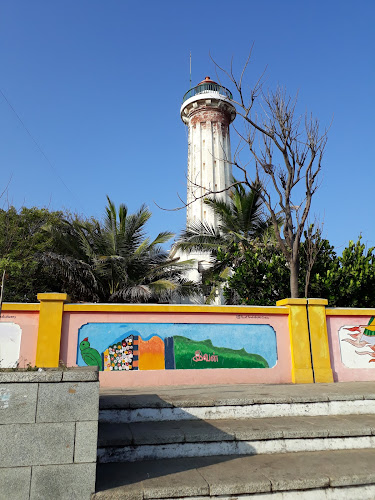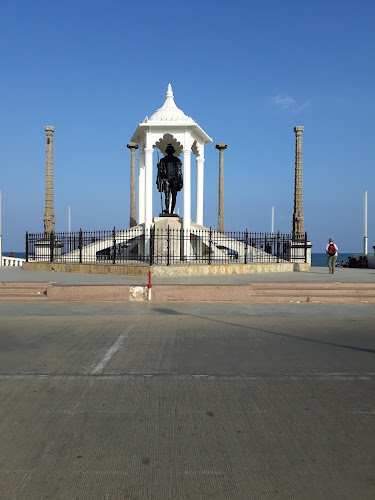We woke up on the last day of our tour of the Temple Towns of Tamil Nadu, India. After breakfast, we had a small celebration for the successful completion of the tour with cake cutting.
At 9.30 am, we started our two hour drive from Pondicherry to Mahabalipuram.
At Mahabalipuram, we were met by our local guide, who was very good with his communication skills.
First we visited the monument complex Pancha Rathas (also known as Five Rathas or Pandava Rathas). Pancha Rathas is an example of monolithic Indian rock-cut architecture, carved during the reign of King Narasimhavarman I (630–668 AD). It is part of the UNESCO World Heritage site inscribed by UNESCO as Group of Monuments at Mahabalipuram.
The place was pretty crowded, as it was a weekend perhaps. School kids and their teachers were having a great time, exploring the place and taking photos.
Each of the five monuments in the Pancha Rathas complex is a monolith, carved over a single, long stone or monolith, of a slightly sloping pink granite and resembles a chariot (ratha).
From South to North, they are in this order - the Dharmaraja Ratha, Bhima Ratha, Arjuna Ratha, and Draupadi Ratha in a line.
Nakula Sahadeva Ratha is to the left side of Arjuna Ratha.
Besides these, there are three large sculptures of Lion, Elephant , and Nandi Bull.
The architectural elegance of the Dharmaraja Ratha is its pyramidal structure which rises in three steps. It is built with a square layout. It is embellished with carvings of Hindu gods Harihara, Brahma, Skanda, Ardhanarishvara and King Narasimhavarman I.
There is also an independent monolithic stone sculpture of Nandi, adjoining this ratha in the open space.
Then there is the Bhima Ratha built to a rectangular plan, with lion mounted columned galleries on two sides.
The next in order is the Arjuna Ratha, similar to Dharmaraja Ratha, with a well decorated and elegant facade.
The Draupadi Ratha, the last in the line, is a square structure, resembling a village hut with thatched roof. There is a fresco of Goddess Durga inside this shrine.
The Nakula Sahadeva Ratha is to the side of Arjuna Ratha. It is comparatively simple.
There is a stone monolithic sculpture of an elephant in the open space, next to this ratha.
We then went to Mamallaa Heritage Restaurant,
where we had thali lunch.
We then walked to the nearby Shore Temple (built in 700–728 AD), a complex of temples and shrines built with blocks of granite, overlooks the shore of the Bay of Bengal. As one of the Group of Monuments at Mahabalipuram, it has been classified as a UNESCO World Heritage Site since 1984.
We could see the waves lashing the shore nearby.
At the time of its creation, the site was a busy port during the reign of Narasimhavarman II of the Pallava dynasty. It is one of the oldest structural (versus rock-cut) stone temples of South India.
Marco Polo and the European merchants who came to Asia after him, called the site Seven Pagodas. One of these is believed to be the Shore Temple. The temple probably acted as a landmark for navigation of their ships. As it appears like a Pagoda, the name became familiar to the seafarers. Why Seven Pagodas? Well, the tsunami of 26 December 2004 that struck the coastline there, exposed an old collapsed temple built entirely of granite blocks. This has renewed speculation that Mahabalipuram was a part of the Seven Pagodas described in the diaries of Europeans, of which six temples remain submerged in the sea. The tsunami also exposed some ancient rock sculptures of lions, elephants, and peacocks that used to decorate walls and temples during the Pallava period during the 7th and 8th centuries.
Though the temple and the surrounding garden were struck by Tsunami, the Shore Temple was not badly damaged, as the water level returned to its normal level within a few minutes.
The Shore Temple complex is a combination of three shrines, built on the same platform. Viewed from the northern end, the temples appear to be a replica of the Dharmaraja Ratha. The main shrine is dedicated to Shiva as is the smaller second shrine. A small third shrine between the two, is dedicated to a reclining Vishnu.
There are sculpted 'Nandi's by the side of the temples.
In 1990, the Archaeological Survey of India (ASI) discovered a miniature shrine with the Bhuvaraha image in an elliptical well type enclosure, dedicated to Shiva.
After that we went to see Arjuna's Penance / Descent of the Ganges which is a monument, measuring 29 m × 13 m. It is a giant open-air rock relief carved on two monolithic rock boulders. The relief is more of a canvas of Indian rock cut sculpture at its best not seen anywhere in India. It is one of the Group of Monuments at Mahabalipuram that were designated as a UNESCO World Heritage Site since 1984. The descent of the Ganges and Arjuna's Penance are portrayed in stone at the Pallava heritage site.
The legend depicted in the relief is the story of the descent of the sacred river Ganges to earth from the heavens led by Bhagiratha. The waters of the Ganges are believed to possess supernatural powers.
In one interpretation, a figure in the relief who is standing on one leg is said to be Arjuna performing an austerity 'Tapas' to receive a boon from Shiva as an aid in fighting the Mahabharata war. The boon, which Arjuna is said to have received, was called Pasupata, Shiva's most powerful weapon.
The relief is carved on two large boulders with a cleft. Above the cleft was a collecting pool, and at one time, water may have flowed along the cleft. Figures in the cleft in the rock are covered with nagas (serpent deities), in anjali posture. The river is said to represent Ganga or the River Ganges emerging from Shiva's head. This provides the basis for an alternative interpretation of the mural.
Another interpretation for the yogi doing penance on one leg is that it is a depiction of Bhagiratha doing severe penance to bring down the Ganges to earth to usher prosperity and happiness to the people. To break Ganga's fall from heaven to earth, she falls onto Shiva's hair, and is divided into many streams by his tresses. The nagas carved in the cleft represent fecundity and wealth. Shiva and other gods are shown blessing the saint. The scene is further accentuated with carvings of kings, sages, artists and animals.
One more interpretation of the myth seen in another part of the panel is that of a cat standing on one leg (apparently as an austerity), and perhaps an iconic figure in the relief. It is interpreted as relating to the Panchatantra story of an ascetic. It denotes the hare luring a bird to come close so that she could she catch and devour it. The artist has brought out the expression on the cat's face, its motives clearly.
A few animals - elephants, deer are all part of the carvings, as also celestial beings as well as hunters and humans.
There are lions ..., an there is a sculpture of a monkey family, the father monkey taking out lice from the mother monkey's hair,
while the little one is resting on her lap.
We then walked to the last site Krishna's Butter Ball.
It is also known as Krishna's Vennai Urandai; it is a gigantic granite boulder resting on a short incline. It is best viewed at sunrise from northwest to southeast or at sundown from northeast to southwest for magical hues.
The boulder is gigantic - approximately 6 meters high and 5 meters wide and weighs around 250 tons. It seems to float and barely stand on a slope on top of 1.2-meter high plinth which is a naturally eroded hill, and is said to have been at the same place for 1200 years. A part of the boulder on top back has eroded away, making it look like a half-spherical rock from the back, while it looks round shaped from other three sides.
Close to Krishna's Butterball, is the two-storey, relatively-undamaged, late 7th century Ganesha Ratha, similar to Bhima Ratha. The first storey has five small vimanas, the second has four, with similar patterns. There are nine ne end has a
The temple facade has two pillars and two pilasters.
The column bases are shaped like seated lions. At the sides of the entrance are two standing dvarapalas with welcoming, bent heads. There is a Ganesh statue in the
We would have loved to stay overnight there and visit all other interesting spots in Mahabalipuram. As I mentioned earlier, we were getting just a taste of each of the temple towns in this tour. We would have to take up separate tours to get a hearty fill ....
We started our drive for Chennai airport at 4 pm. We reached there at 6 pm. We were handed packed dinner, which we enjoyed at the airport before catching our flight back home to Pune.
It was 22 February 2020. We spotted very few persons wearing masks at the airport, you can't spot any mask in the above picture. CORONA scare was yet to sink in. We were glad to be home. I was a bit apprehensive and took care for the next ten days. Thankfully nothing untoward happened. Wow! That was close .... In less than a week, things started worsening and CORONA cases started spiraling ...... Within a month, temples and places of worship were shut down too......



























































































